Is “round” the only allowable shape for planets?
Sign up for the Starts With a Bang newsletter
Travel the universe with Dr. Ethan Siegel as he answers the biggest questions of all
It’s hard to believe, but it’s already been more than 2000 years since humanity first not only discovered that planet Earth is round in shape, but was able to measure its size as well. Not only are the Moon and Sun similarly round, but every planet is as well. Even many of the non-planets in our Solar System get in on this “round” action, too. Around the giant planets, Jupiter’s four largest moons, four of Saturn’s five largest moons, all five of Uranus’s largest moons, and Neptune’s largest moon as well are all round. So are dwarf planets Ceres, Eris, Pluto, plus numerous other Kuiper belt and Oort cloud objects. There are some far-flung objects as little as ~200 km in radius that are round, while Neptune’s Proteus and Saturn’s Iapetus, both significantly larger, are not.
Why are so many of these large, massive objects round in nature? Why, above a certain size, do all objects become round? Is it impossible for other shapes to exist for the largest objects of all? It’s kind of strange when you think about it: every planet we’ve measured is round, and the same seems to hold for exoplanets as well, at least, to the best precision we’ve been able to measure them. It’s almost enough to make one wonder: what would happen if a planet were shaped like a cube, or pyramid, and why haven’t we found any? This is a question that science can not only answer, but going through the physics at play here tells us why round — or, at least, hydrostatic equilibrium — is the only possible option beyond a certain size.

Although Earth and Venus are the two largest rocky objects in the Solar System, Mars, Mercury, as well as over 100 of the largest moons, asteroids, and Kuiper belt objects have all achieved hydrostatic equilibrium. Ganymede and Titan are larger than Mercury, but Callisto, at 99% of Mercury’s size, has just one-third of Mercury’s mass. All told, all known objects with radii greater than 800 km are in hydrostatic equilibrium, but below that threshold, it isn’t a certainty any longer.
The first thing to realize is that, under the laws of the fundamental forces that govern our Universe, it’s possible for any amount of normal matter, large or small, to clump and bind together. Individual atoms and even subatomic particles, like atomic nuclei or free electrons, exist in great abundances in stellar systems, as well as in interstellar space. Neutral atoms typically and freely link up to form molecules, which can exist freely or as parts of other systems, and molecules themselves can clump together in amounts both great and small.
While there are nuclear and electromagnetic forces at play, both of which can easily overwhelm any other forces on small scales, when you get large amounts of mass together, it’s actually the weakest force of all that wins: gravity. If you bring enough normal matter together in one place — regardless of the type, phase, origin, or nature of matter that you have — it will contract until it’s a single, gravitationally bound object.
When these objects are small, they tend to form minuscule, dustball-like structures. These grain-like particles aren’t actually held together via gravity, but rather via electrostatic forces. Simply bringing them close to the Sun, where they’re exposed to things like solar radiation and the solar wind, is enough to destroy them. If you want something more robust, you have to look to larger masses, enabling the force of gravity to become more dominant.
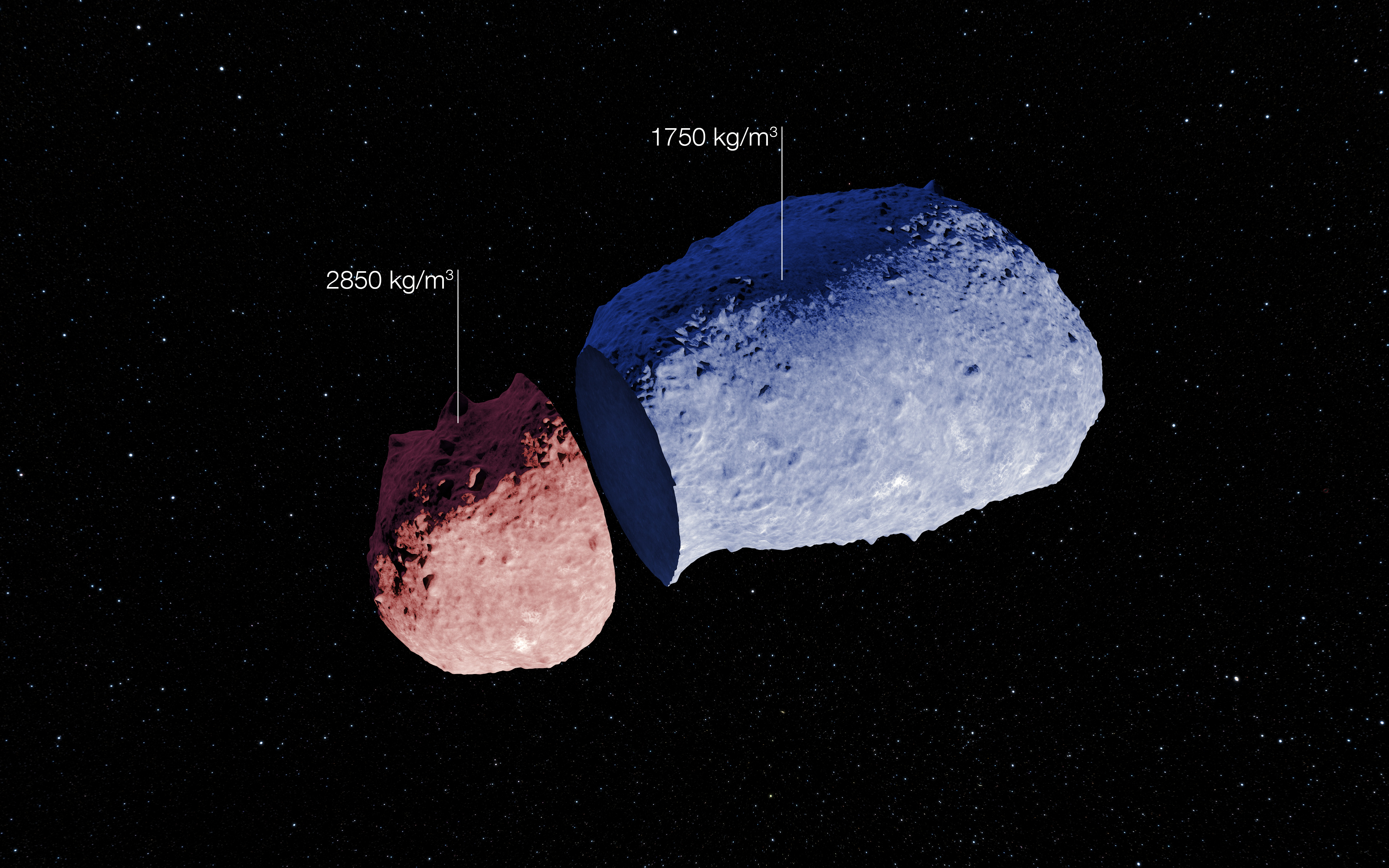
A schematic view of the strange peanut-shaped asteroid Itokawa. Itokawa is an example of a rubble-pile asteroid, but determinations of its density have revealed that it is likely a result of a merger between two bodies that have different compositions. It lacks the necessary mass/gravity to pull itself into a round shape.
Take the above-pictured asteroid, for example: Itokawa. Itokawa is large and massive enough to be its own gravitationally bound structure, weighing in at about ~30 million tons. It’s only a few hundred meters across on a side, but that’s enough to illustrate, at least at this scale, what gravitation can and cannot do. When you’ve accumulated more than a “grain” of matter but not more than a few million tons, here are the three main features that describe the object you’re likely to wind up with.
- A “rubble pile” body. Instead of being one solid object, you get what looks like a collection of many different grains and pebbles, all held together through their mutual gravitation.
- An object that isn’t differentiated. If you have a lot of mass together, you get a differentiation of your layers, where the densest materials sink to the center, forming a typically metal-rich core, while the less-dense rocky, icy, and more volatile materials (like a mantle or crust) “float” atop them. Itokawa, and other objects of comparably small masses and sizes, can’t do that.
- A composition that shows the merger of different bodies. This one isn’t necessary, but it does happen frequently, and Itokawa is a spectacular example of it: the two portions of the “peanut” that composes Itokawa have dramatically different densities, indicating that these were once two separate objects that have since, gravitationally, merged together.
All told, these represent classes of objects that can indeed hold themselves together through the gravitational force, but they still aren’t compelled to be round.

Comet 67P/Churyumov-Gerasimenko was imaged many times by the ESA’s Rosetta mission, where its irregular shape, volatile and outgassing surface, and cometary activity were all observed. The comet’s nucleus itself would have to have been much larger and more massive to be pulled into a “round” shape by self-gravitation.
Let’s answer that question next: why don’t these small objects become round? It’s because the forces between atoms and molecules — governed by electrons and the electromagnetic force — are stronger than the force of gravity at this scale. Gravitation is always attractive and pulls every particle of matter toward the center of mass of the objects that they’re a part of. Gravity may always be at play, but there are other forces between atoms and molecules that can help determine their shape and configuration.
Ice crystals form in lattices, silicate rocks can form amorphously, dust particles can get compacted into soils or even solid shapes, and so on. When a gravitational force is applied to a large body or collection of bodies, it exerts a pressure: a force over an area. If that pressure is great enough, it will override whatever initial conditions or shapes an object possesses to start with, and it compels that object to reshape itself into a more energetically stable configuration.
In the case of self-gravitating bodies, overcoming whatever random initial shape and configuration you start with is the first obstacle you face, and just how much mass is required depends on what your object is made out of. You can form a cube, a pyramid, or whatever arbitrary shape nature can enable (I typically call such randomly-shaped bodies “potatoes”), but once your object becomes too massive, and the force of gravity becomes too large, you won’t maintain that initial shape any longer. Instead be pulled into a round (or approximately round) shape, as the force of gravity always points toward the center-of-mass of your object.
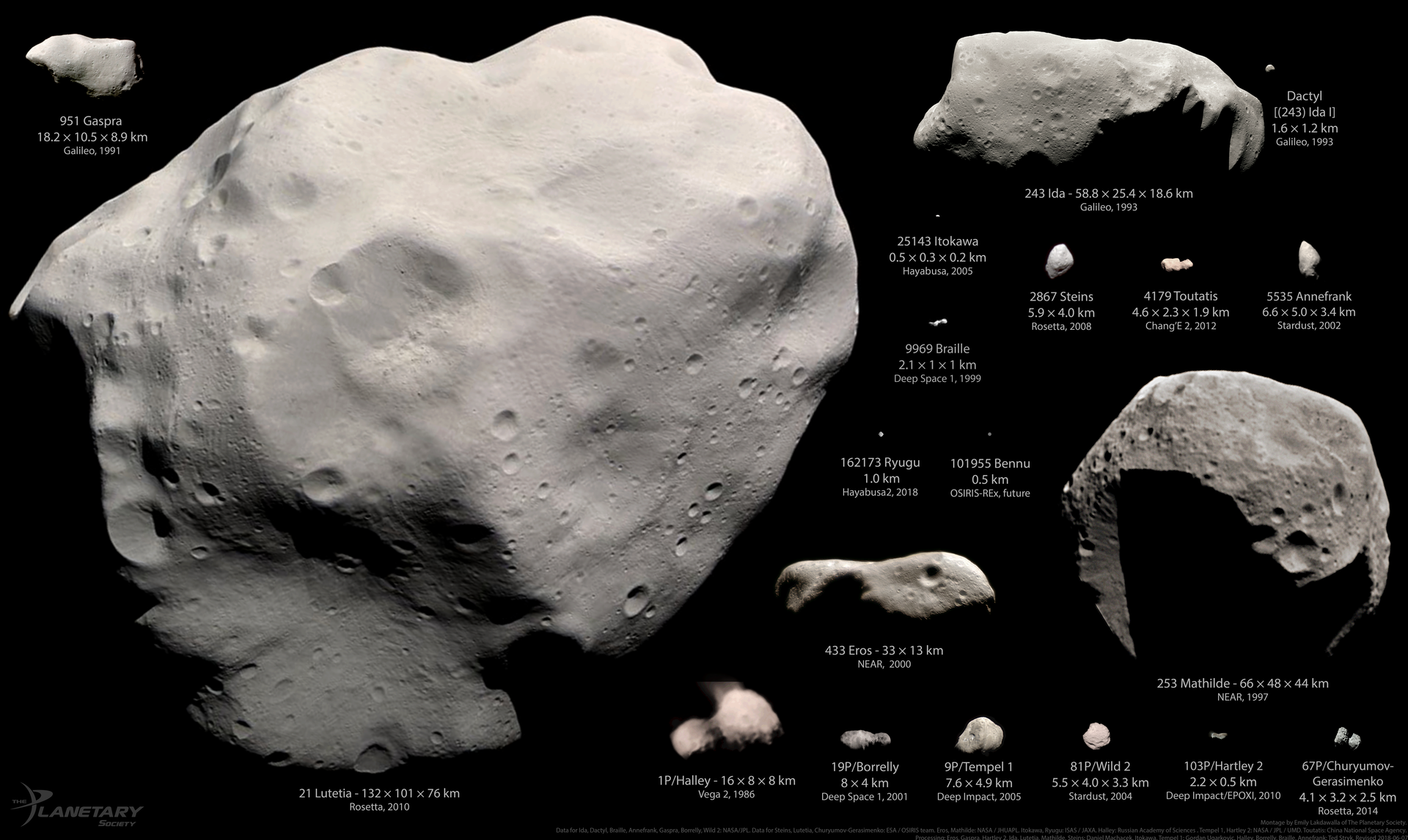
This selection of asteroids and comets visited by spacecraft spans many orders of magnitude in size, from sub-kilometer bodies to objects more than 100 km on a side. However, none of these objects have enough mass to be pulled into a round shape. Gravitation can hold them together, but electromagnetic forces are primarily responsible for their shapes.
So where do the actual, physical thresholds lie? It turns out that if your object is below about 1018 kilograms (a quadrillion tons or so) in mass, it will be below about 100 kilometers in radius, and that is always too small, or low in mass, to allow gravity to pull such an object into a round shape. Itokawa falls short of this threshold by a factor of many millions, as do most of the known asteroids.
However, if you can accumulate enough material to rise above this first mass and size threshold, you’ve got a chance to become roughly round in nature.
Saturn’s moon Mimas, for example, is slightly under 200 kilometers in radius, but is undoubtedly rounded. In fact, it’s the smallest astronomical body presently known that’s configured in a round shape. Presumably, this shape came about through Mimas’s own self-gravitation, where Mimas is the innermost large moon of Saturn, completing an orbit around the ringed planet in under 24 hours. Mimas is very low in density, only barely denser than water-ice, suggesting that it’s made up largely of volatiles: low-density ices that are easy to deform under the force of gravity.
Were Mimas composed largely of rocks or even metals, it would have to be larger and more massive to self-gravitate into a sphere: as large as 400 or 500 kilometers in radius, in the most extreme cases.
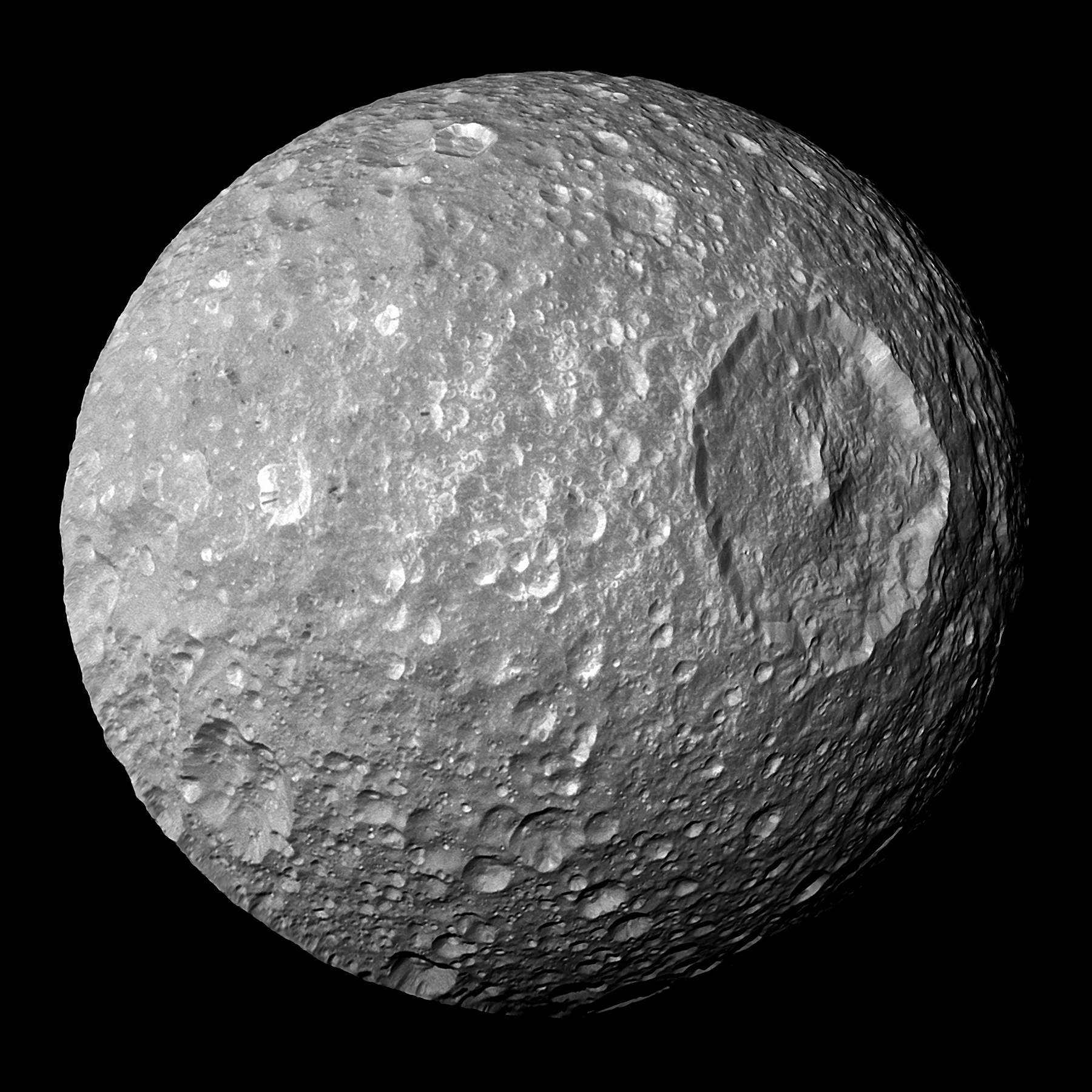
Mimas, as imaged here during the closest fly-by of Cassini in 2010, is only 198 kilometers in radius, but is quite clearly round owing to its self-gravitation. Being made mostly of ice, it does what the larger asteroids Vesta and Pallas cannot: pull itself into a spheroidal shape. However, it doesn’t appear to truly be in hydrostatic equilibrium, as the large crater visible here, Herschel, shouldn’t persist with its present properties if the world were truly shaped by self-gravitation.
The notion of “round,” of course, is only what we call a first-order approximation. For realistic objects, including planet Earth, they’re still going to possess large features that lead your object to depart from the shape that self-gravitation would otherwise lead to on a world that becomes rounded. Mimas, in fact, demonstrates this, with its Death Star-like appearance owing to its enormous crater: so large it’s almost a third of Mimas’s diameter. The crater walls are over 5 km high and the crater floor is more than 10 km deep; in fact the surface on the opposite side of Mimas from this crater is highly disrupted. The impact that created this crater must have nearly destroyed Mimas entirely, with the gravitation of Mimas, post-impact, being insufficient to pull it back into a more spherical shape.
This example illustrates an important distinction: the difference between being “round” and being in “hydrostatic equilibrium.” Self-gravitation can pull you into a mostly round shape easily if you’re over 200 kilometers in radius (and you’re made primarily of ices) or over 400 kilometers in radius (if you’re primarily made of rocky material). But being in hydrostatic equilibrium is a more difficult bar to clear: you have to have your shape primarily determined by a combination of two main factors: self-gravitation and rotation. The shape that such a world, planet, or star in hydrostatic equilibrium takes on will be the same shape a self-gravitating drop of spinning liquid water would take on.

The four largest asteroids, all shown here, have been imaged with NASA’s Dawn mission and the ESO’s SPHERE instrument. Ceres, the largest asteroid, is the smallest known body in hydrostatic equilibrium. Vesta and Pallas are not, but Hygeia’s status is indeterminate; it may yet be.
Although Mimas is round, it’s not an example of an object in hydrostatic equilibrium. Although numerous asteroids are larger than Mimas, including Vesta, Pallas, and Hygiea, they’re still potato-shaped, and not in hydrostatic equilibrium even though they’re kind of round. The smallest body verified to be in hydrostatic equilibrium is the largest asteroid: the dwarf planet Ceres, with a radius of about 470 kilometers. On the other hand, the largest body known not to be in hydrostatic equilibrium is Saturn’s bizarre moon Iapetus, with a radius of around 735 km, whose planet-spanning equatorial ridge wouldn’t be able to exist if gravity and rotation alone determined its shape.
For a solid body like a rocky planet or moon, the big question is whether your gravity can make you behave in what physicists call a plastic fashion. In physics and materials science, plastic doesn’t mean “made out of the by-products of oil,” but rather describes how certain classes of materials deform when placed under pressure. When you subject a material to stresses arising from factors like:
- tension,
- compression,
- bending,
- or torsion,
those materials will normally respond by elongating, compressing, buckling, twisting, or by deforming in some way, shape, or form in general.
If you have a material that deforms plastically, those distortions and deformations can become permanent. A large, massive body that deforms plastically, if it’s massive enough, will be deformed by a sufficient amount by gravity to be pulled back into hydrostatic equilibrium, so that its overall shape is once again determined by your rotation and gravity alone. If it’s not massive enough, plastic deformation can still lead to that body becoming round, but it won’t be in hydrostatic equilibrium.
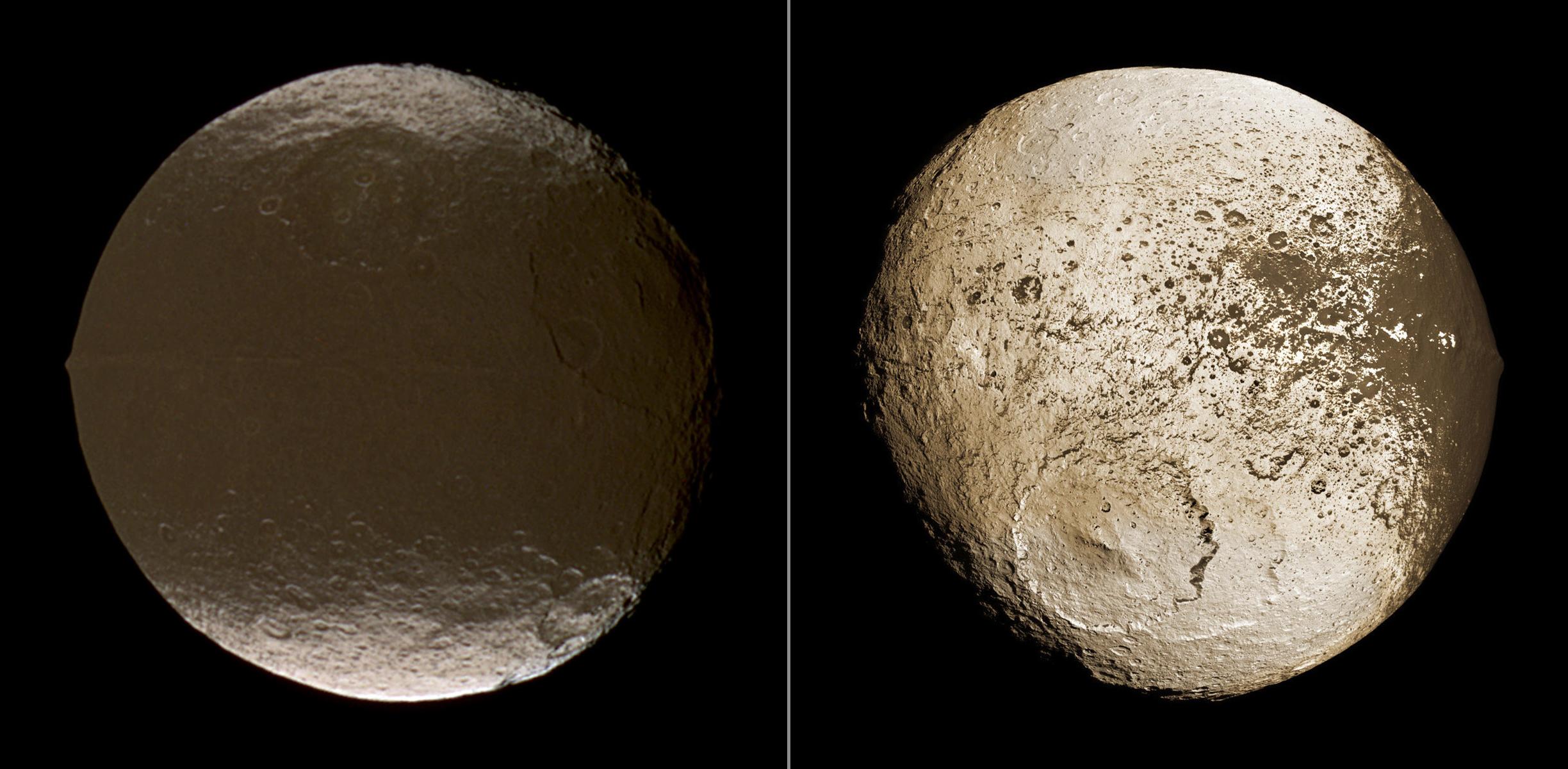
These two global images of Iapetus show its large impact feature and its huge equatorial ridge. In concert with its other properties, these features demonstrate that Iapetus is not in hydrostatic equilibrium, making it the largest world in the Solar System known to not be.
For objects primarily composed of ices, roundness first arises at about 200 kilometers in radius, but hydrostatic equilibrium doesn’t arrive until that body reaches about double that size: 400 kilometers in radius. For rocky objects, roundness won’t be achieved unless the object’s radius is about 400 kilometers, and won’t necessarily reach hydrostatic equilibrium unless its radius is greater: up to 750 kilometers in radius may be needed.
Objects that live in that in-between region could either be in hydrostatic equilibrium or not, and we’re not certain about the status of many of the known ones. Rock-and-ice Hygeia, with a radius of only 215 km, is fairly round and might even be in hydrostatic equilibrium. Saturn’s moon Enceladus, at 252 kilometers in radius, is close to hydrostatic equilibrium, but the asteroids Pallas and Vesta, at 256 and 263 km, severely depart from even basic roundness. Pluto’s large moon Charon, with a radius of 606 km, might not have quite achieved hydrostatic equilibrium; that aspect of Charon is still an open question. The largest two Uranian moons, Titania and Oberon, are probably in hydrostatic equilibrium; the next three, Umbriel, Ariel, and Miranda, are round, but haven’t necessarily achieved hydrostatic equilibrium for themselves.
It’s only once a body reaches around 800 kilometers in radius that hydrostatic equilibrium is practically guaranteed. For the known objects, everything above that size is not only round, but exhibits features that indicate hydrostatic equilibrium as well.
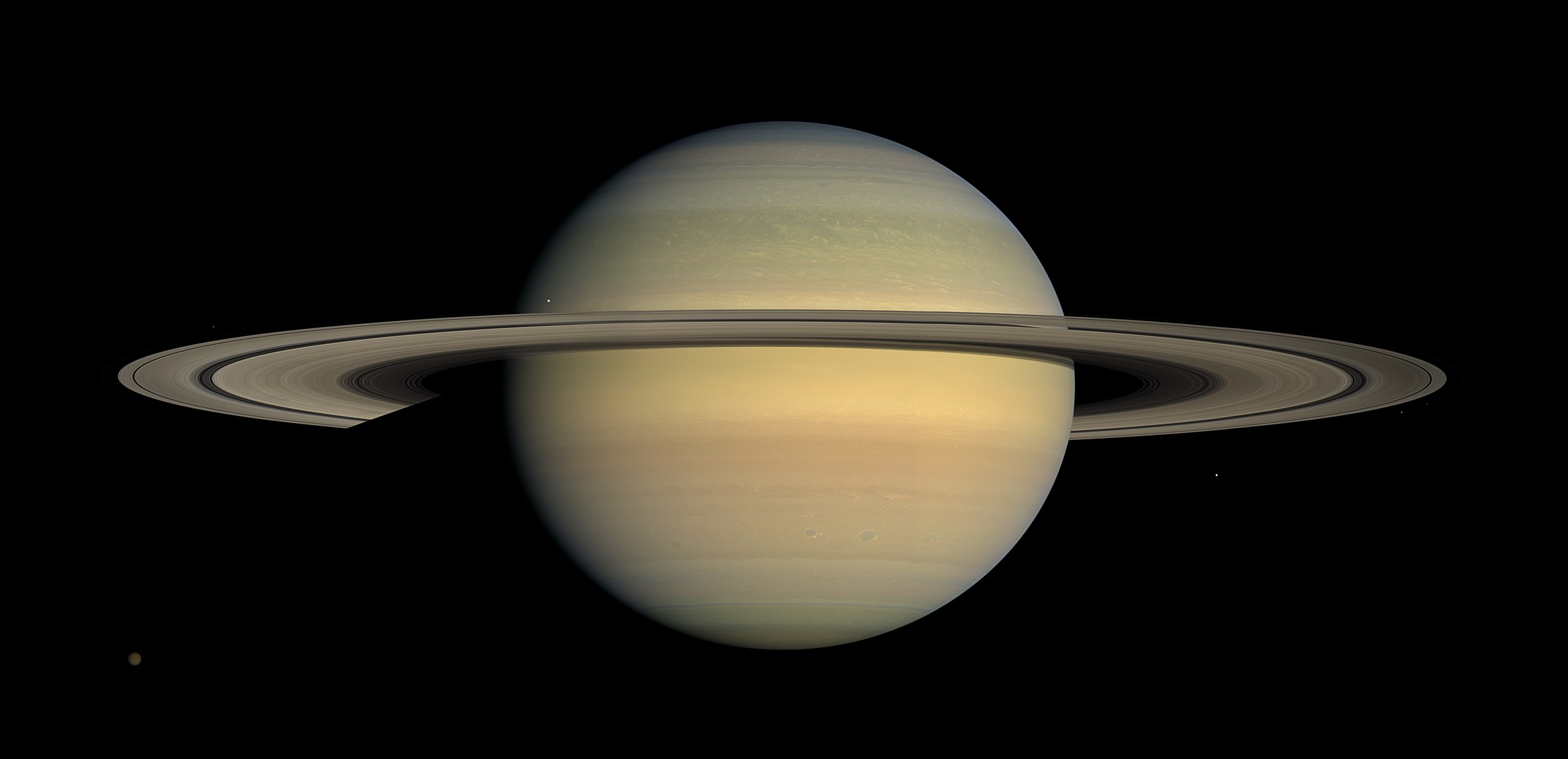
Saturn, as photographed here by Cassini during the 2008 equinox, isn’t quite round (as it’s more of an oblate spheroid), but is in hydrostatic equilibrium. With its low density and rapid rotation, Saturn is the most flattened planet in the Solar System, with an equatorial diameter that’s more than 10% larger than its polar diameter. Its colors and “bands” are largely due to different atmospheric layers appearing dominant in visible light at different latitudes.
The dwarf planets Haumea, Eris, and Pluto (along with Makemake, which happens to be only 715 km in radius) are all in hydrostatic equilibrium. Neptune’s Triton, Earth’s Moon, Saturn’s Titan, and all four of the Galilean moons of Jupiter are in hydrostatic equilibrium as well. All eight of the planets have their shape primarily determined by gravity and rotation, as does the Sun. In fact, we’re pretty confident that this is a universal rule: if your object has a radius that’s greater than about 800 kilometers, regardless of its composition, it’s going to be in hydrostatic equilibrium.
But here’s a fun fact that you may not appreciate: many objects — including many planets and stars — rotate so quickly that it’s very clear that they aren’t round, but rather take on a squashed shape known as an oblate spheroid. Earth, due to its 24 hour rotation, isn’t quite a perfect sphere, but has a larger equatorial radius (6378 km) than a polar radius (6356 km). Saturn’s rotation is even faster, completing a rotation in just 10.7 hours, and its equatorial radius (60,268 km) is almost one full “Earth” radius larger than its polar radius (54,364 km).
This doesn’t apply to everyone, however. The Moon and Mercury, for instance, are both incredibly slow rotators. They’re each only ~2 km larger in radius in the equatorial direction than the polar one, making them very spherical rocky planets. But do you know which body is the most perfect sphere in the Solar System? The Sun. With an average radius of 696,000 kilometers, its equatorial radius is only ~5 km larger than its polar radius, making it a perfect sphere to an incredible 99.9993% precision.

This image of the Sun, taken on April 20, 2015, shows a number of features common to all stars: magnetic loops, prominences, plasma filaments, and regions of higher and lower temperatures. However, the slowly-rotating Sun is the most perfect sphere in the Solar System, with a polar and equatorial diameter that are identical to 99.9993% precision.
Although there are many factors at play in determining the ultimate shape of an object, there are really only three main categories that bodies fall into.
- If an object is either too low in mass and/or too small for its material composition, it will simply take on whatever shape it happened to have by the luck-of-the-draw during its formation. Practically all objects below ~200 kilometers in radius have this property, regardless of composition.
- If an object is larger and more massive, that initial shape will get reconfigured into an approximately round one, a threshold that gets crossed between ~200 and 800 km in radius, depending on the object’s specific composition. When and if a major distortive event happens to such an object, like an impact (in the case of Mimas), a deposition (possibly around Iapetus’s equator), or a change to its orbital properties (which may have happened in the case of Saturn’s Phoebe), it will likely retain an imprinted “memory” of that event.
- And finally, if an object reaches above ~800 kilometers in radius, it will be in hydrostatic equilibrium: massive enough so that gravity and rotation primarily determine its shape, with only small imperfections (like mountains, valleys, and rifts) superimposed atop that general shape.
In terms of mass, that maximum size threshold corresponds to only one-thousandth of Earth’s overall mass. If gravity can bring together that much mass, the object that results should always be in hydrostatic equilibrium. Roundness, on its own, is neither quite enough to make an object a planet nor to mandate that it be in hydrostatic equilibrium, but all of our Solar System’s planets have more than enough mass to achieve those milestones nonetheless. At these sufficiently heavy masses, the irresistible force of gravity ensures a spheroidal shape just as surely as drops of liquid water form spheres in space. Under the laws of nature that we know of, they simply couldn’t have been configured in any other way.
An earlier version of this post first appeared as an Ask Ethan column in November of 2021; this current version was updated in November, 2024.
Sign up for the Starts With a Bang newsletter
Travel the universe with Dr. Ethan Siegel as he answers the biggest questions of all
Source link
